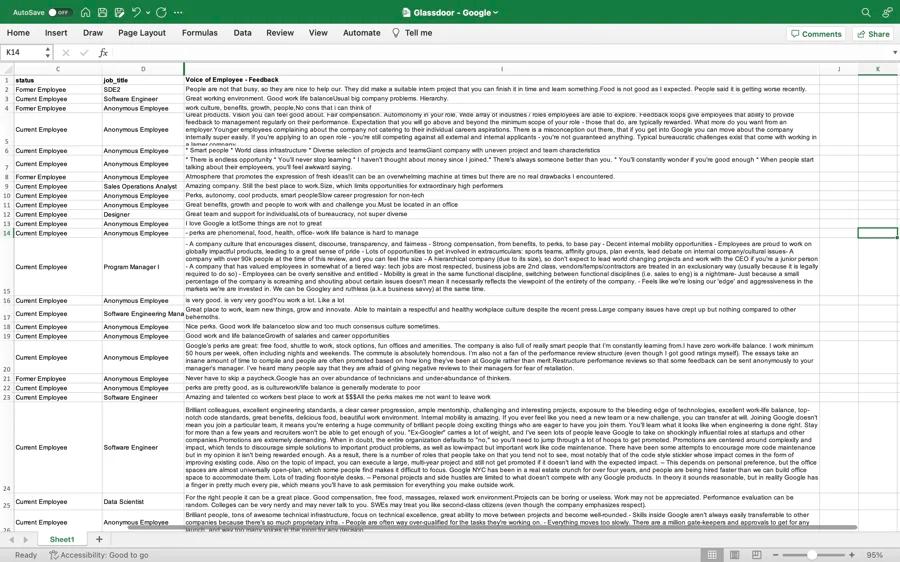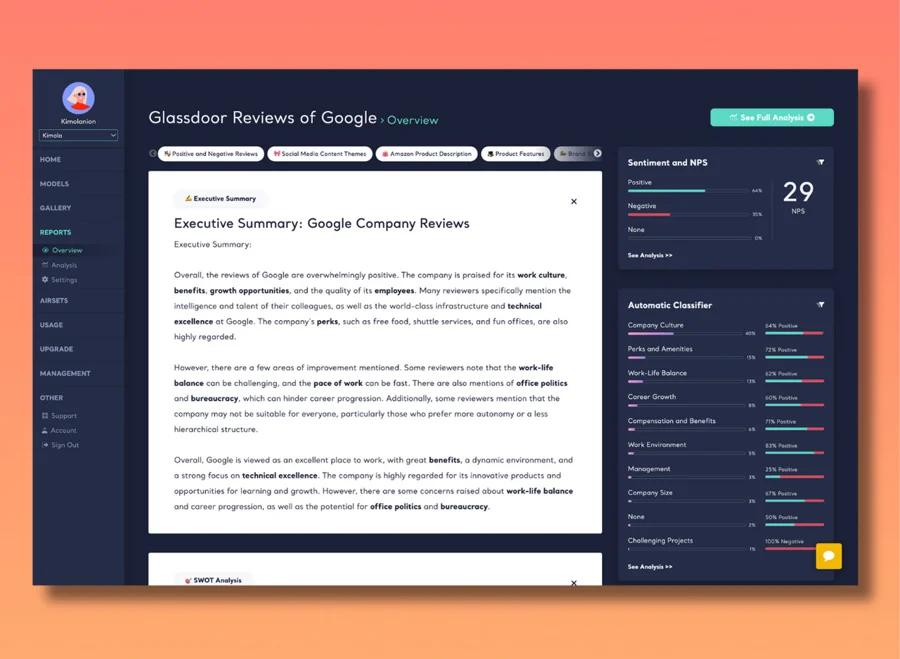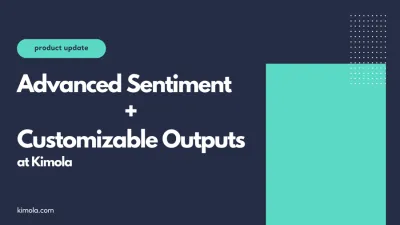5 Steps to Analyze Voice of Employee Data Effectively
Jan 18, 2026 - 7 minute read
In today's business world, understanding not only business processes but also the emotional experiences of employees has become critical for organisations. It allows employees to freely express their concerns, ideas, complaints, suggestions and perspectives to leaders and management. It takes work to get through these critical processes.
This article will present Kimola's text analysis technology to better hear your employees' voices in your workplace.
Here is the content map of the blog post for curious minds:
- What is The Employee Voice?
- Why is it important?
- How to collect feedback from employees?
- How to analyze voice of employee?
- Voice of Google Employees - Use Case
What is the Employee Voice?
"Voice of Employees" (VoE) is a concept that refers to the opinions, feedback, and perspectives of employees within an organisation. This is a way for companies to gather and listen to the input and insights of their workforce. The aim is to understand employees' experiences, ideas and concerns and use this information to improve various aspects of the workplace.
This approach recognises that employees can provide valuable insight into workplace culture, processes, and areas that need attention or improvement.
The Importance of Employee Voice
The employee voice is an essential element for an organisation, and Human Resources (HR) departments value several benefits of listening to and understanding this voice. Here are some reasons for this importance:
The Voice of Employeeis an essential element for an organisation, and Human Resources (HR) departments value several benefits of listening to and understanding this voice. Here are some reasons for this importance:
Employee Participation and Loyalty: Valuing employees' opinions, involving them in business processes, and encouraging their participation in business decisions can increase employee loyalty.
Workforce Satisfaction: Employee satisfaction can directly impact job performance. Understanding and meeting the workforce's expectations makes employees more satisfied.
Innovation and Creativity: Employee ideas and suggestions can contribute to the organisation being more innovative and creative. New perspectives from employees' experiences can be critical in business processes and product development.
Conflict and Problem-Solving: Employee voice can be an early warning system to identify and resolve potential problems. This can help prevent or reduce the impact of potential conflicts.
Performance Improvement: Employee feedback allows the organisation to evaluate its performance in specific areas and make improvements.
Employer Brand Building: An organisation that values employee voices can build a strong employer brand. This is important for attracting qualified candidates and retaining existing employees.
Human Resources Strategies: Listening to the employee's voice can help shape human resources strategies. These strategies may include workforce planning, talent development and performance management.
The employee's voice and evaluation of this feedback can contribute to organisations creating a healthier, fairer and more effective work environment. Using this feedback, Human Resources departments can improve the organisation's human resources policies and practices, optimise workforce management and play a fundamental role in sustainable success.
Process for Assessing Employee Voice
1- Collecting Feedback from Employees
Many different methods can be used to collect Employee feedback data.
Surveys: Sending regular surveys to employees on various topics effectively ensures broad participation and getting opinions on specific issues. Surveys can provide valuable data on overall work satisfaction, leadership styles, training needs, and more.
Face-to-Face Interviews and Focus Groups: One-on-one interviews or small focus groups can be used to collect more in-depth and qualified data. This method allows employees to express their emotional states, suggestions and experiences in more detail.
Electronic Feedback Platforms: Businesses can collect employee feedback through various electronic platforms. By using interactive intranet sites, online discussion forums, or dedicated feedback tools, employees can share their thoughts instantly and effortlessly.
Performance Evaluations: Routine performance evaluations can be used to understand employees' strengths, areas for development, and expectations for their jobs. These assessments provide essential information for achieving individual and organisational goals.
Social Media and Communication Tools: Social and internal communication tools can enable employees to share their daily feelings, thoughts and suggestions. These platforms can be used to capture real-time and candid feedback.
2- The Art of Data Analysis for VoE
Analysing data obtained from employee voices is a process that requires special attention and skill. One of the main challenges encountered in this process is processing diverse and large data sets. Combining data from different departments, positions, and sources and extracting meaningful patterns requires analytical skill and care. In addition, the data obtained from employees' voices is often emotional and subjective, requiring a sensitive approach for accurate analysis. Maintaining data integrity and reliability, especially with anonymity policies, can complicate the analysis process.
Kimola, leveraging NLP technology, "Open-ended questions addressed to employees are an effective method to understand the problems in the workplace and collect various opinions. These questions allow employees to express their thoughts in detail and cover various topics. Multiple label classification is used to better understand and classify the data obtained. Multi-label allows a response to be classified under more than one category or topic. This method is beneficial when employees touch on a wide range of topics. For example, an employee's answer might fall into the "workplace culture" and "communication issues" categories.
Analysing multi-label data, identifying popular topics, and presenting prominent topics based on employee voices is also possible. “This can help managers identify priority issues in the workplace and develop solution-oriented strategies.”
5 Simple Steps to Analyze Voice of Employee (VoE)
I will show you how to analyze the Voice of Employee in 5 simple steps and demonstrate the Kimola process.
1- Sign up to Kimola for free.
Signing up to Kimola is free and requires no credit cards.
2- Drag and drop the Excel file that has feedback in it.
It can be an excel or a csv file, and you will only need to drag and drop the file to the homepage of the dashboard.
3- Choose the text column in 2 seconds.
Choose the feedback column that Kimola will analyze.
4- Click Next, choose Executive Summary and Create!
Your report will be ready in a couple of minutes. Don’t forget to share it internally after downloading the PDF version.
5- View results
Well, that’s not a step, it’s the result, but now you can understand how easy it is!
Sample Data Analysis for Google, Voice of Employee
I have acquired a Voice of Employee (VoE) dataset from Kaggle, curated by Nitin Kumar. This dataset compiles Glassdoor reviews about Google, offering insights into employees' perspectives on the positive and negative aspects of working at the company. Here is my dataset:

I dragged and dropped the Excel file into the homepage of Kimola, where it says “Upload Your Data”, and chose the text column and executive summary from Interpretation Gallery:

Here are the results:

Analysis Results
You've finished your data analysis, now it's time to implement the results. Text analysis tools like Kimola are fast and easy to use, allowing you to apply your analysis continuously and in real-time. When you analyse data obtained through routine surveys on a quarterly, monthly, or even daily basis, you can listen to employees' voices through a continuous window. This is called the "employee feedback loop."
Once your analysis process is complete, it is essential to “close the loop” and communicate to employees that you have implemented the changes they suggested and that feedback is always welcomed. At this point, you can make the necessary adjustments by taking into account the advantages offered by Kimola in this process.
In summary
Recognising and valuing the employee's voice is crucial for organisational advancement. Kimola's innovative text analysis technology is essential, streamlining diverse feedback collection methods such as surveys and interviews. This allows organisations to gain valuable insights that positively impact employee participation, satisfaction, innovation, conflict resolution, and overall performance. Kimola's NLP technology effectively handles the challenge of analysing varied and subjective data, providing a streamlined process with comprehensive text analysis and visualisation. Embracing the employee voice fosters a healthier work environment and positions organisations for sustained success by refining human resources strategies and building a strong employer brand. Kimola empowers organisations to listen, understand, and respond to the voices within their workforce, paving the way for ongoing improvement and enduring growth.








